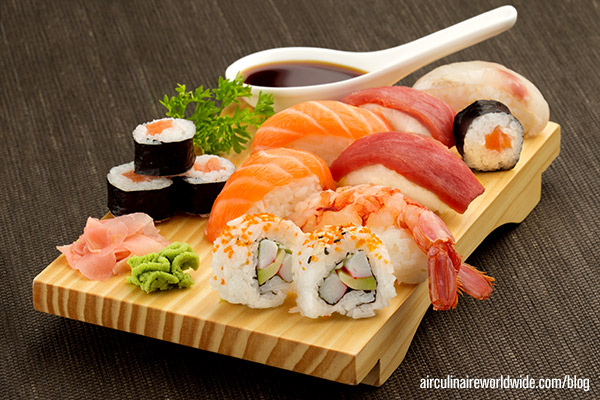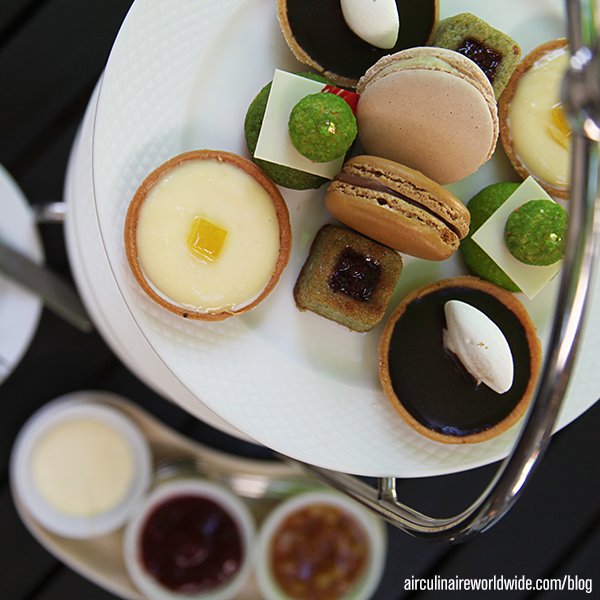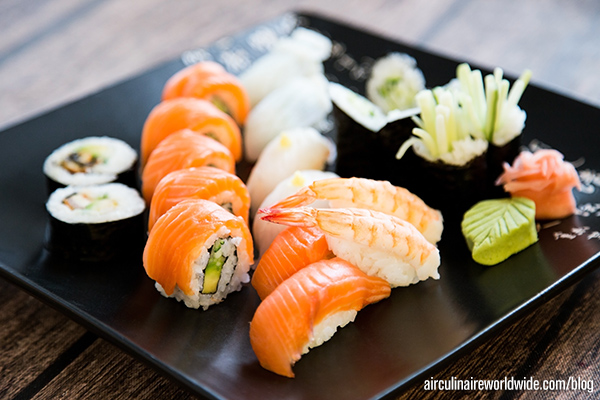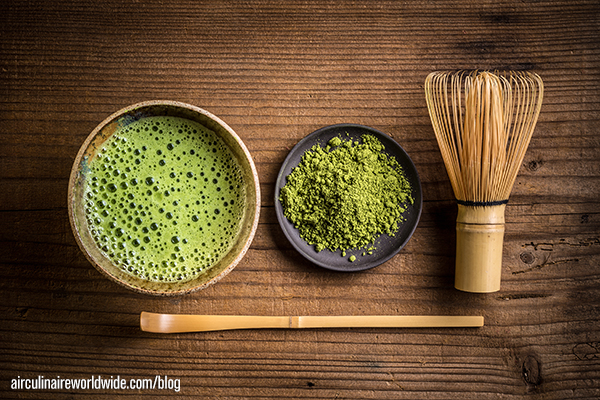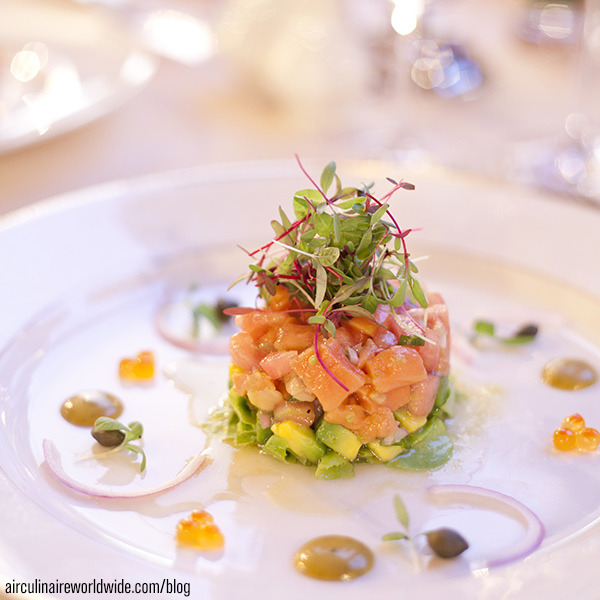Sushi and sashimi is a $14 billion dollar industry in Japan alone. Not to mention that it has become a global phenomenon, from the smallest of take-outs to the finest of Japanese restaurants, sushi can be purchased almost everywhere. Sushi and sashimi make a regular appearance on the menus of our corporate jets, and corporate flight attendants are regularly serve some of the finest sushi and sashimi available. But before we think about the in-flight dining experience with sushi, what do we really know about this food we have come to enjoy?
What is Sushi?
Sushi is a unique style of Japanese cuisine, marked by the use of vinegared rice that is topped with a variety of ingredients. Originally, sushi was a combination of fermented fish with rice preserved in salt. This traditional recipe was a staple in Japan for over a thousand years, until the Edo period, when modern sushi started to evolve. Traditional Japanese sushi generally contains only one type of fish or vegetable, unlike westernized versions that come with a variety of ingredients. The California roll we are accustomed to, is one of the most common examples of westernized sushi. Originally, salmon was not used for either sushi or sashimi. In fact, salmon was introduced into sushi in the 1980s by Norwegians, yet another western addition.
Common Types of Sushi
There are hundreds of types of sushi and sashimi, but some of the most common menu options include:
- Ama Ebi – Sweet shrimp (raw)
- Ebi – Cooked shrimp
- Hamachi – Yellowtail
- Ika – Squid
- Inari – Fried tofu wrapper filled with sushi rice
- Maguro – Tuna
- Sake – Salmon (Not to be confused with the alcoholic drink)
- Tako – Octopus
- Tamago – Egg (Cooked – usually sweetened with sugar)
- Tobiko – Fish Eggs
- Unagi – Eel
What is Sashimi?
Sashimi is made from only the finest cuts of raw fish. Since the fish and seafood used in sushi and sashimi are eaten raw, the fish used is of far superior quality than the fish used for cooking. Sushi chefs examine the firmness, colour and other attributes of the fish in order to determine if the quality is suitable for usage as sashimi. The most prized portion of the fish is the fatty cut, especially in Bluefin Tuna (the “toro” – middle). Sashimi is often eaten first, so other flavors do not detract from its purity.
What is an Itame?
“Itame” is the Japanese name for a sushi chef. An itame is highly-skilled, and the most senior itames can spend years in training. The Japanese believe that people “eat with the eye,” hence an itame will make even the smallest sushi and sashimi platters look like works of art.
Sushi Condiments
Soy sauce, “wasabi” (Japanese horseradish) and “gari” (sweet pickle) are palate cleansers and digestions aids. Seaweed, grated carrot and decorative items are used to dress sushi. The traditional way to separate items was using baran leaves. The green plastic leaves you find on your take-out sushi represent the baran leaf. Green tea, such as matcha and other premium varieties, are often served with sushi.
Sushi Serving Styles
The classic Japanese way to serve sushi is on a fresh bamboo leaf. “Omakase” (roughly translates to “I’ll leave it to you” but has the same implication as chef’s choice, in this setting) sets are served one or two pieces at a time, or the sushi may arrive together on a wooden or ceramic platter. “Kaiten” sushi, in which sushi is placed on a conveyor belt and circulated for patrons to choose from, also known as a “sushi train,” has grown in increasing popular worldwide since it is an easy way to enjoy a variety of sushi.
Which Sushi to Avoid
“Fugu,” Japanese puffer fish, is highly-toxic and can be fatal if not prepared properly. Therefore fugu should be avoided. In order to properly prepare this dish, an itame has to train for as much as ten years. In order and the itami must pass an examination.
Sushi Etiquette
Depending on the type of sushi ordered, some rolls will come from the itame already dressed with a dash of horseradish. Heaping wasabi into the soy sauce is not necessary and may even be offensive to the chef. Wasabi can detract from the taste of finer cuts of fish found in high-end establishments. Traditionalists also maintain that sushi should be turned upside-down and then dipped into the soy sauce. This practice ensures only the topping is covered with soy sauce and the rice does not absorb too much, which would cause it to fall apart.
Sushi Food Safety Guidelines Onboard Your Aircraft
Legally, the fish used for sashimi must be frozen initially. This ensures parasites are killed and oxidation is prevented. Sushi and sashimi are high-risk foods, so you must take great care when collecting the sushi. Sushi must be chilled for and during transit below 4 C / 39 F. Traditional sushi is made with slightly warm rice, which can encourage rapid bacterial growth. The two most common of which are Bacillus Cereus (a spore-forming bacteria that is prevalent with rice) and Staphylococcus auerus (a common pathogen). Both of these bacteria can rapidly cause acute food poisoning. Always ensure that sushi is received cold, and that you keep it chilled, sealed and at a safe temperature in-flight.
Questions?
If you have any questions about this article, contact Yasmin Milner at ymilner@corporateflighttraining.com.
| This is an article by guest author Yasmin Milner of Corporate Flight Training. Yasmin is based in the United Kingdom and is an industry expert in corporate aviation. Any thoughts expressed in this article are entirely Yasmin’s and do not necessarily reflect the views of Air Culinaire Worldwide. |
If you would like to be considered for becoming a guest author, please contact socialmedia@airculinaire.com.
